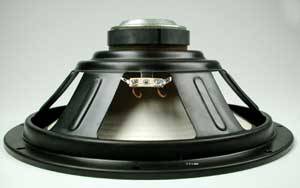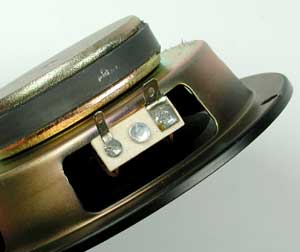In the last section, we saw that sound travels in waves of air pressure fluctuation, and that we hear sounds differently depending on the frequency and amplitude of these waves. We also learned that microphones translate sound waves into electrical signals, which can be encoded onto CDs, tapes, LPs, etc. Players convert this stored information back into an electric current for use in the stereo system.
A speaker is essentially the final translation machine -- the reverse of the microphone. It takes the electrical signal and translates it back into physical vibrations to create sound waves. When everything is working as it should, the speaker produces nearly the same vibrations that the microphone originally recorded and encoded on a tape, CD, LP, etc.
Traditional speakers do this with one or more drivers.
Making Sound: Diaphragm

A typical speaker driver, with a metal basket, heavy permanent magnet and paper diaphragm
A driver produces sound waves by rapidly vibrating a flexible cone, or diaphragm.
- The cone, usually made of paper, plastic or metal, is attached on the wide end to the suspension.
- The suspension, or surround, is a rim of flexible material that allows the cone to move, and is attached to the driver's metal frame, called the basket.
- The narrow end of the cone is connected to the voice coil.
- The coil is attached to the basket by the spider, a ring of flexible material. The spider holds the coil in position, but allows it to move freely back and forth.
Some drivers have a dome instead of a cone. A dome is just a diaphragm that extends out instead of tapering in.
Making Sound: Voice Coil

The wire that runs through the speaker system connects to two hook-up jacks on the driver.
When the electrical current flowing through the voice coil changes direction, the coil's polar orientation reverses.
The voice coil is a basic electromagnet.
If you've read How Electromagnets Work, then you know that an electromagnet is a coil of wire, usually wrapped around a piece of magnetic metal, such as iron. Running electrical current through the wire creates a magnetic field around the coil, magnetizing the metal it is wrapped around. The field acts just like the magnetic field around a permanent magnet: It has a polar orientation -- a "north" end and and a "south" end -- and it is attracted to iron objects. But unlike a permanent magnet, in an electromagnet you can alter the orientation of the poles. If you reverse the flow of the current, the north and south ends of the electromagnet switch.
This is exactly what a stereo signal does -- it constantly reverses the flow of electricity. If you've ever hooked up a stereo system, then you know that there are two output wires for each speaker -- typically a black one and a red one.
Essentially, the amplifier is constantly switching the electrical signal, fluctuating between a positive charge and a negative charge on the red wire. Since electrons always flow in the same direction between positively charged particles and negatively charged particles, the current going through the speaker moves one way and then reverses and flows the other way. This alternating current causes the polar orientation of the electromagnet to reverse itself many times a second.
Making Sound: Magnets
When the electrical current flowing through the voice coil changes direction, the coil's polar orientation reverses. This changes the magnetic forces between the voice coil and the permanent magnet, moving the coil and attached diaphragm back and forth.
So how does the fluctuation make the speaker coil move back and forth? The electromagnet is positioned in a constant magnetic field created by a permanent magnet. These two magnets -- the electromagnet and the permanent magnet -- interact with each other as any two magnets do. The positive end of the electromagnet is attracted to the negative pole of the permanent magnetic field, and the negative pole of the electromagnet is repelled by the permanent magnet's negative pole. When the electromagnet's polar orientation switches, so does the direction of repulsion and attraction. In this way, the alternating current constantly reverses the magnetic forces between the voice coil and the permanent magnet. This pushes the coil back and forth rapidly, like a piston.
When the coil moves, it pushes and pulls on the speaker cone. This vibrates the air in front of the speaker, creating sound waves. The electrical audio signal can also be interpreted as a wave. The frequency and amplitude of this wave, which represents the original sound wave, dictates the rate and distance that the voice coil moves. This, in turn, determines the frequency and amplitude of the sound waves produced by the diaphragm.
Different driver sizes are better suited for certain frequency ranges. For this reason, loudspeaker units typically divide a wide frequency range among multiple drivers. In the next section, we'll find out how speakers divide up the frequency range, and we'll look at the main driver types used in loudspeakers.


